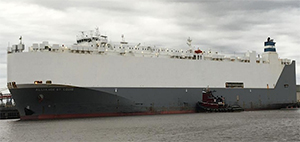Investigators have determined that an engine room fire early last year aboard the U.S.-flagged vehicle carrier Alliance St. Louis likely stemmed from an improperly secured pipe plug.
Alarms sounded on the 653-foot ship at 0252 on Jan. 16, 2017, while it was underway in the Gulf of Mexico about 190 miles south of New Orleans. Crew used a fixed CO2 system to extinguish the fire. No one was injured, but the incident caused $3.7 million in damage.
The National Transportation Safety Board (NTSB) determined that a pipe plug on a fuel pump for the main engine’s No. 6 cylinder fell out, allowing fuel to spray onto the engine’s exhaust gas pipe manifold. Engine vibration likely caused the plug to loosen over time.
“Contributing to the fire was the improper attachment of a fuel spray shield to the top cover, which allowed fuel to spray directly onto the cylinder’s hot exhaust pipe and ignite,” the NTSB said.
Alliance St. Louis left Port Arthur, Texas, for Jacksonville, Fla., at 0442 the day before the fire. The ship’s second assistant engineer made his final engine room check at 2300 and found no signs of trouble.
Crew noticed alarms indicating a fire in the engine room about four hours later, and shortly afterward the ship’s electrical plant failed. An emergency generator activated, and crew responded to the general alarm and mustered at emergency stations.
“In accordance with the emergency plan and station bill assignments, the crewmembers closed the engine room ventilation dampers and control stops to prevent the spread of smoke and reduce the supply of oxygen,” the NTSB report said. “They also shut the fuel and lube oil quick-closing valves to cut off potential fuel sources to the fire.”
The power failure rendered a hyper-mist fixed fire-suppression system inoperable. At about 0311, crew wearing firefighting suits and self-contained breathing apparatus entered the smoky engine room. A portable fire extinguisher did not put out the flames.
 |
|
This photo shows the fuel pump housing and top cover for the No. 6 cylinder with the missing pipe plug, with the dislodged plug and a new plug pictured in the inset. |
|
Courtesy NTSB |
About 14 minutes later, the chief engineer re-entered the room alone and determined the main engine was not on fire. After accounting for crew, the master authorized releasing CO2 into the engine space for two minutes.
The NTSB determined the “timely and effective” use of the CO2 system likely kept the fire from spreading and also helped reduce damage to the engine room.
Agency investigators focused on the No. 6 cylinder head on the Doosan-MAN B&W two-stroke engine as the likely fuel source for the fire. They found that an aft pipe plug was missing from the top cover of the cylinder’s fuel pump, which would have allowed the fuel to spray, the NTSB said.
Alliance St. Louis’ chief engineer later found the missing plug in a catch-all area around the base of the No. 6 cylinder. It did not show any signs of wear or fire damage.
Maintenance teams overhauled that specific cylinder about seven months before the incident. Ship engineering personnel told the NTSB they would apply an adhesive, then tighten pipe plugs by “feel” rather than to a certain setting. Pipe plugs had never before vibrated loose.
“The pipe plug was likely not sufficiently torqued into the top cover during the last inspection because the crew did not recognize this as a crucial step in maintaining the reliability of the fuel oil system,” the report said.
“The instruction book’s section ‘Overhaul of Top Cover Complete’ contributed to the crew’s lack of awareness about this hazardous situation because it did not depict the fuel oil return passages or describe the purpose of the pipe plugs,” it continued.
Maersk Line Ltd. subsidiary Farrell Lines operated the 13-year-old Alliance St. Louis. Maersk said it would not comment on the NTSB findings and Farrell did not respond to inquiries.

